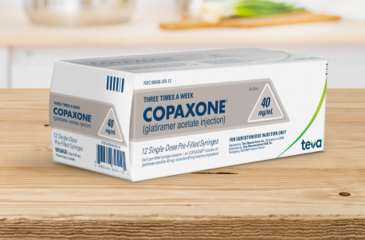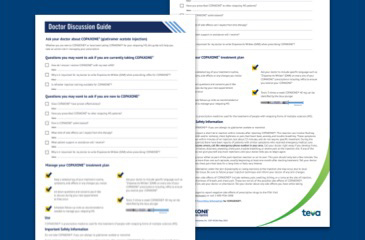COPAXONE® INJECTION SIDE EFFECT FACTS
Knowing what to look for can help you manage your relapsing multiple sclerosis (RMS).1
Side effects are possible, so here’s what you need to know.1
WHAT ARE THE MOST COMMON SIDE EFFECTS OF COPAXONE®?1
-
skin problems at the injection site (redness, pain, swelling, itching, or lumps)
-
rash
-
shortness of breath
-
flushing (redness to your cheeks or other parts of the body)
IMMEDIATE POST-INJECTION REACTIONS1
When using COPAXONE® (glatiramer acetate injection), you may experience immediate post-injection reactions (serious side effects right after or within minutes of injecting COPAXONE®) or other side effects (which can happen at any time during the course of your treatment).
CALL YOUR DOCTOR RIGHT AWAY IF YOU EXPERIENCE ANY OF THESE IMMEDIATE POST-INJECTION REACTIONS FROM COPAXONE®1:
-
flushing (redness to your cheeks or other parts of the body)
-
chest pain
-
fast heart beat
-
anxiety
-
breathing problems or tightness in your throat
-
swelling, rash, hives, or itching
If you have symptoms of an immediate post-injection reaction, do not give yourself more injections until advised to do so by a doctor.
OTHER SERIOUS SIDE EFFECTS INCLUDE1:
-
chest pain (This can be as part of an immediate post-injection reaction or a symptom by itself; this type of chest pain usually lasts a few minutes and can begin around 1 month after starting COPAXONE® treatment. Call your doctor right away if you experience chest pain while using COPAXONE®).
-
damage to your skin (damage to the fatty tissue just under your skin's surface [lipoatrophy] and, rarely, death of your skin tissue [necrosis] can happen when you use COPAXONE®. Damage to the fatty tissue under your skin can cause a "dent" at the injection site that may not go away).
YOU CAN REDUCE YOUR CHANCE OF DEVELOPING DAMAGE TO YOUR SKIN BY1:
-
following your doctor's instructions for how to use COPAXONE®
-
rotating injection areas each time you use COPAXONE®
-
downloading our Skin Care Guide for techniques to help keep your skin healthy while injecting COPAXONE®
These are not all the possible side effects of COPAXONE®. For example, according to a study, 3% of patients experience weight gain. For more information, ask your doctor or pharmacist. Call your doctor for medical advice about side effects. You may report side effects to the FDA at 1-800-FDA-1088.1
HEAR HOW YOU CAN EMPOWER YOURSELF WITH FACTS ABOUT YOUR MS THERAPY, FROM AN MS SPECIALIST:

WHAT IF I’M SWITCHING TO COPAXONE® FROM ANOTHER THERAPY?
Be sure to follow the advice of your doctor and schedule injection training with them to make sure you’re injecting properly. Refer to our injection training video and guide for an overview and the Instructions for Use in the Prescribing Information.
HOW DOES COPAXONE® INTERACT WITH OTHER MEDICATIONS?1
Although not fully studied, COPAXONE® has no known significant interactions with medications commonly used in MS patients. This includes concurrent use with corticosteroids (up to 28 days). COPAXONE® has not been formally evaluated in combination with interferon beta.
SHOULD I TAKE COPAXONE® IF I’M PREGNANT?1
Before you use COPAXONE®, tell your doctor if you are pregnant or plan to become pregnant. It is not known if COPAXONE® will harm your unborn baby. For more information, download our MS & Pregnancy brochure.
Reference:
-
COPAXONE® (glatiramer acetate injection) Current Prescribing Information Parsippany, NJ. Teva Neuroscience, Inc.
You are about to leave COPAXONE.com and enter a website operated by a third party.
Would you like to continue?
The information on this site is intended for healthcare professionals in the United States. Are you a healthcare professional in the United States?



